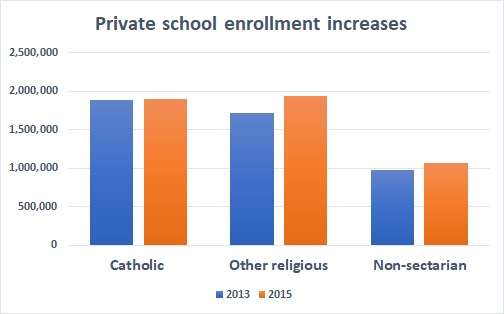Editor’s note (Aug. 23): This post contains significant updates and corrections. The original version erroneously reported a drop in private school enrollment between 2013 and 2015. The error occurred because it compared 2013 data that included Pre-K students with 2015 data that did not. We regret this mistake. The revised post provides accurate year-to-year comparisons.
The U.S. Department of Education is out this week with a new report on private school data from across the country. The last such data came out two years ago. Here’s what the numbers from the 2015-16 school year show.
Here’s what the numbers from the 2015-16 school year show.
Enrollment in private schools reversed its decline. In addition, there were more private schools and more private school teachers.
Between 2013 and 2015, the number of students rose 7 percent, to 4,903,596.
The number of teachers rose faster, by about nine percent, to 481,558.
Meanwhile, the number of schools jumped by nearly 1,000, to 34,576.
This factoid might be related. In the fall of 2013, roughly 36 percent of private schools had fewer than 50 students. Two years later, 46 percent of private schools fell in that category.
Enrollment in faith-based schools is growing. But enrollment in Catholic schools was close to flat. It increased by a little more than half of one percent. Enrollment other religious chools grew faster — by nearly 13 percent during the same period. Non-sectarian schools, meanwhile, grew by nearly 10 percent.

Perhaps charter school competition is a factor. There may be a legal case for faith-based charters, but right now they are rare in the real world. So it’s possible a faith-based mission can help private schools differentiate themselves and attract a different group of students.
Private school students remain disproportionately white. A majority of the nation’s public school students are children of color, but 68.6 percent of those in private schools were white in the fall of 2015. That number barely budged from two years earlier, when nearly 69.6 percent were white.
Catholic schools were more likely to enroll Hispanic students than other private schools.
In 2015, more than 15.6 percent of Catholic school students were Hispanic, compared to 10.2 percent in private schools overall. And the percentage of Hispanic students is increasing faster in Catholic schools than in other private schools. Do school choice programs, or the Catholic school renaissance, play a role here?
Meanwhile, in Florida, private school enrollment continues to rise, bolstered by growing scholarship programs. It stands to reason that diversity is increasing faster in Florida, too, given the demographics of participants the largest such program.
(That program is the Florida tax credit scholarship, which this blog’s publisher, Step Up For Students, helps administer.)


